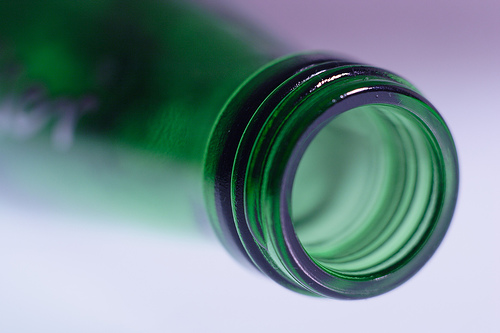f1.8 - the background is out of focus
When photographers talk about depth of field, they are talking about how much of the photograph is in focus.
If the main object in the photograph is in focus, but nothing else is, we say that there is a shallow depth of field. If the main object and the areas in front of and behind it are all in focus, we say that there is a greater depth of field. Looking at the example pictures below might make this clearer.
With most cameras you can adjust the depth of field by adjusting the aperture, but there are several things that affect the depth of field:
aperture - the smaller the aperture (i.e. the larger the f number), the larger the depth of field. That's why things sometimes seem clearer when you squint (your eyelids create a smaller aperture), and why a pin hole camera doesn't need to be focussed (it has a very small aperture, and therefore a large depth of field).
focal length - the "longer" the lens, the shallower the depth of field. A telephoto lens doesn't have a great depth of field, but with a wide-angle lens most things will be in focus. That's why things sometimes go out of focus when you zoom in with a zoom lens, but not when you zoom out!
distance to the object - the nearer to the lens you focus, the shallower the depth of field. This means that you need to me more careful when photographing objects that are close to you than when you are taking pictures of landscapes. There is a distance called infinity marked on a lens's focussing ring beyond which everything will be in focus. For example, if you take a picture of a landscape, the moon or the sun is never out of focus, even though it is thousands or millions of times farther away than the trees across the field.
sensor (or film) size - the smaller the sensor (or the area of the film you use), the greater the depth of field. With some smaller compact digital cameras, almost everything is always in focus, and it isn't really possible to get a shallow depth of field. There's not a lot you can do about that, other than buy another camera.
You won't always be able to change all of these things - especially if your camera has a fixed lens - so photographers usually adjust the depth of field by changing the aperture or f-value. A larger aperture (lower f-value) gives a shallower depth of field, and a smaller aperture (larger f-value) gives a greater depth of field.
You can use depth of field to your advantage - if there are distracting things in the background when you are taking a photo, use a large aperture (small f-value) so that the background is out of focus and less distracting. Look at the two photos of Pingu below - which do you prefer? They were taken from the same position with the same lens (50mm), but different apertures.
The pictures below show, in a more gradual way, the effect of changing the aperture. The camera and ruler were in the same position (with the camera on a tripod) for each photo - all that changed was the aperture (and the shutter speed to ensure that the photo was properly exposed).
The focal length of the lens is 50mm, and the 10cm mark on the ruler was about 15cm from the front of the lens - taking a picture this close gives a shallow depth of field and exaggerates the effect of changing the aperture. Click on the apertures beneath the picture to see what the ruler looks like when taken through that aperture.
When you're taking a picture, ask yourself whether all of the subject really needs to be in focus. Sometimes the effect can be better if parts of the subject are out of focus. Look at the example below - would a fully in-focus picture of an Appletiser bottle be as interesting?
